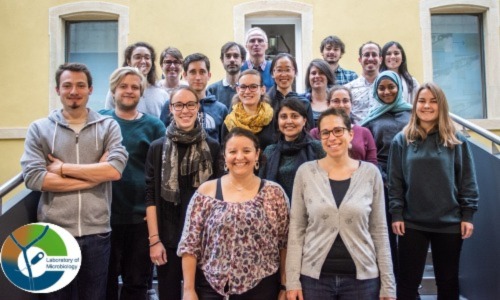Behind the bacterial spore research
Posted on March 2, 2023 by Dr Andrea Corona
Dr Andrea Corona takes us behind the scenes of her latest publication "Multiple roads lead to Rome: unique morphology and chemistry of endospores, exospores, myxospores, cysts and akinetes in bacteria" published in Microbiology.

What is your name, job title and institution?
My name is Dr Andrea Corona. I recently finished my PhD at the Laboratory of Microbiology at the University of Neuchâtel, Switzerland. The lab is focused on microbial ecology and is led by my thesis supervisor Professor Pilar Junier. We study multiple topics including: microbial diversity, plant-bacteria/fungi interactions, biocontrol, phage transport, and production of edible fungi. During my time at the University, I focused on the diversity of bacterial spores in the environment. This was a challenging and highly interesting topic.
Tell us a little bit about your research and why it is important
Survival is the first goal of all organisms in nature and they have developed different survival strategies. One amazing survival strategy is the formation of spores by bacteria. During my PhD I investigated the diversity of bacterial spores in the environment and attempted to develop a spore sorting method.
Bacteria have been able to colonise in the most extreme environments. Some of them have evolved survival strategies that allow them to ‘travel in time’. By producing spores, bacteria are able to reduce their metabolic activity to ‘sleep’ during harsh environmental conditions and ‘wake up’ when the environmental conditions are optimal for their development… thus, in a sense, travelling in time.
In the face of climate change, understanding the diversity and abundance of bacterial spores and other dormant structures might help us to understand and/or predict shifts in the microbial community and their effect on the environment.

Tell us about your most recent paper
In my most recent paper, titled “Multiple roads lead to Rome: unique morphology and chemistry of endospores, exospores, myxospores, cysts and akinetes in bacteria”, we systematically evaluated the morphology and chemical composition of spores produced by diverse model sporulating bacteria. We showed that the differences observed in the morphology, formation and resistance of different model bacterial spores is also reflected in their cellular structure and chemical composition.
This study was important as it showed that all bacterial spores are different and thus a ‘new spore’ does not necessarily have to present all the characteristics of a typical endospore, which by many microbiologists is considered as the model spore.
In this paper, we also presented the principles for the development of a Raman-activated spore sorting platform to isolate endospores from environmental samples. This platform would provide a faster and more reliable method to isolate endospores from environmental samples.
Why did you decide to investigate this hypothesis/question?
To assess the diversity of bacterial spores in the environment you need to have a ‘spore marker’, but little research has been done on other models of survival cells such as cyts, akinetes, and myxospores. Thus, we were interested in finding a common marker between the different bacterial models.
What do you hope the future implications of this research will be?
I hope that the definition of bacterial spore will no longer be a synonym for endospore and that the concept of the sporobiota will also be extended to other environments and not just the gut microbiome.
What do you enjoy most about your work?
The opportunity to work with microorganisms that are so fascinating, and getting reminded of how much we still do not know about microorganisms and their role in the environment.
You can read Dr Andrea Corona's article "Multiple roads lead to Rome: unique morphology and chemistry of endospores, exospores, myxospores, cysts and akinetes in bacteria" in Microbiology.
